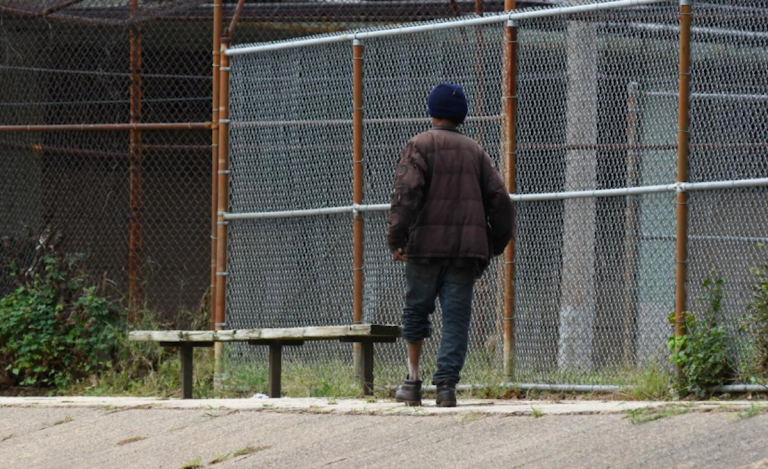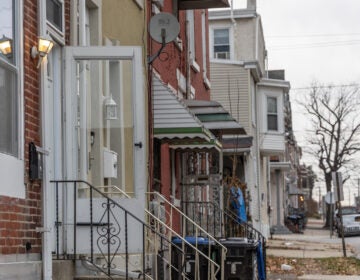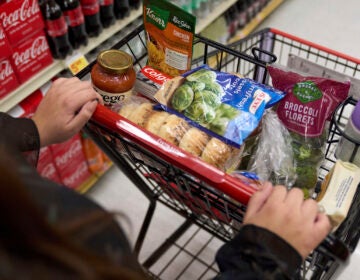Dip in black poverty draws skepticism
A drop in the poverty rate for Black Philadelphians reported in recent census estimates has been met with skepticism.

A man walks in North Philadelphia on Friday (Abdul Sulayman/The Philadelphia Tribune)
This story originally appeared on The Philadelphia Tribune.
—
A drop in the poverty rate for Black Philadelphians reported in recent census estimates has been met with skepticism by some who say the numbers are moving in the opposite direction.
The poverty rate for Blacks and African-Americans was estimated to decrease from 30.8 percent in 2016 to 27.1 percent in 2017, according to the U.S. Census Bureau’s annual American Community Survey. The margin of error was 1.9 percent.
The percentage of Blacks and African-Americans who were experiencing poverty in 2017 was the lowest it has been in a decade, according to the new estimates.
Meanwhile, the Black population in Philadelphia has remained relatively stable since 2010.
“The first reaction I would have to that is I would question it,” said Atif Bostic, board chairman for Philadelphia Opportunities Industrialization Center, or OIC, about the poverty declines. “African-Americans are overrepresented as it relates to poverty.”
“That data doesn’t reflect the conditions on the ground that we see here in West Philadelphia,” said Jamila Harris-Morrison, executive director of the nonprofit ACHIEVEability.
ACHIEVEability, which works to reduce poverty in the city, saw a sharp rise of 19 percent in the number of people seeking services in 2017 compared to the previous year for issues that include food insecurity, emergency rental or utility assistance, and help finding a job, Harris-Morrison said.
The organization, she added, worked with more than 2,100 people in 2017 and was on track to at least match that this year.
The rising numbers, Harris-Morrison said, “tells us that there are still people really struggling to lift themselves out of poverty.”
Bostic said the OIC is “still seeing more and more and more people come in.”
Among the leading drivers of poverty in the African-American community was unemployment, especially for those who have been formerly incarcerated, Bostic said.
Blacks account for one of the highest unemployment rates in the city at 11.9 percent, which is higher than Philadelphia’s overall unemployment rate of 9.1 percent, according to newly released estimates. The national unemployment rate is 3.9 percent.
Bostic said poverty in cities tend to become concentrated in areas where resources are scarce and the people are underserved, which only perpetuates the issue. He called for the city to offer more job training and workforce opportunities, as well as improve education.
“When we look at it overall, Philadelphia has a tremendous way to go,” Bostic said.
Mel Wells, president of One Day at a Time, said the numerous issues negatively affecting the Black community — poor education, crime, a glut of single-parent households — continue to outweigh any poverty decline.
“Even though if a number may change 2 or 4 percent, we can’t feel it because the problems and issues that still lay in our community actually cover it up,” said Wells, who heads the organization that offers services for those in poverty and recovery.
Judith Levine, associate professor of sociology at Temple University, said she wasn’t surprised that social service organizations weren’t seeing marked differences in their own numbers.
“I’m not sure if you’re an agency serving a population that you’re going to see a huge difference when there is still 27 percent of African-Americans in poverty,” Levine said.
She also cautioned the Census figures estimates based on a sample size of residents and there were margins of error.
“It is possible that it’s not really down and that this is somewhat a statistical artifact,” she said.
The city’s Health and Human Services division did not respond to requests for comment.
Harris-Morrison credited the city with making strides to better coordinate cross-sector collaboration to address poverty, as well as the city’s efforts to launch new programs and policies in recent years.
But she added that deep, racially concentrated poverty won’t change without more political will to take on the structural issues.
“You have pockets of the city where you have generations that have not even known what looks like to live outside of the walls of poverty,” Harris-Morrison said. “So it’s going to be very difficult for that family or that household to move within one generation (out of poverty).”
 The Philadelphia Tribune is one of 21 news organizations producing Broke in Philly, a collaborative reporting project on solutions to poverty and the city’s push toward economic justice. See all of the reporting at Broke in Philly.
The Philadelphia Tribune is one of 21 news organizations producing Broke in Philly, a collaborative reporting project on solutions to poverty and the city’s push toward economic justice. See all of the reporting at Broke in Philly.
WHYY is your source for fact-based, in-depth journalism and information. As a nonprofit organization, we rely on financial support from readers like you. Please give today.




